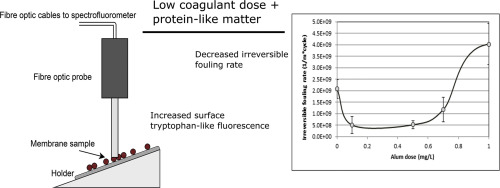当前位置:
X-MOL 学术
›
Water Res.
›
论文详情
Our official English website, www.x-mol.net, welcomes your
feedback! (Note: you will need to create a separate account there.)
Characterization of UF foulants and fouling mechanisms when applying low in-line coagulant pre-treatment
Water Research ( IF 11.4 ) Pub Date : 2017-08-30 , DOI: 10.1016/j.watres.2017.08.064 Nicolas M. Peleato , Raymond L. Legge , Robert C. Andrews
Water Research ( IF 11.4 ) Pub Date : 2017-08-30 , DOI: 10.1016/j.watres.2017.08.064 Nicolas M. Peleato , Raymond L. Legge , Robert C. Andrews

|
Fluorescence spectroscopy was used as a characterization method to examine organic fouling of single ultrafiltration (UF) fibres at bench-scale. Low doses of coagulant were applied to modify organic properties, without significant formation of precipitates. This approach compliments previous studies investigating coagulation as a pre-treatment method for UF fouling control, which have principally focused on reduction of foulant concentrations. Using a continuous system, short time-scale fluorescence results demonstrated significant adsorption of humic components to virgin membrane fibres. Following an initial adsorption phase, protein-like material was the only organic component to be significantly removed by UF. Low doses of coagulant (<1 mg/L as alum; < 0.043 mg/L as Al3+) were observed to significantly reduce irreversible fouling rates for two different surface waters. Paralleling reduced irreversible fouling, surface tryptophan fluorescence resulting from material adsorbed to the fouled membrane increased, as measured using a fibre optic probe. Analysis of peak shifts in the protein-like component revealed a red-shift at low coagulant dose, possibly indicative of greater exposure of tryptophan residues resulting from conformational changes in the protein structure. It is hypothesized that low coagulant doses modified membrane-foulant interactions, resulting in increased adsorption of protein-like matter to the surface. Subsequent interactions of bulk foulants with the adsorbed organic monolayer discouraged further adsorption and reduced irreversible fouling potential.
中文翻译:

使用低在线凝结剂预处理时,UF污垢的特征和结垢机理
荧光光谱法用作表征方法,以在实验室规模下检查单个超滤(UF)纤维的有机结垢。使用低剂量的凝结剂可改善有机性能,而不会形成明显的沉淀物。这种方法补充了以前的研究,该研究将混凝作为超滤结垢控制的预处理方法进行了研究,这些研究主要集中在降低结垢浓度上。使用连续系统,短时间尺度的荧光结果表明,腐殖质成分明显吸附到原始膜纤维上。在最初的吸附阶段之后,类蛋白物质是唯一被超滤显着去除的有机成分。低剂量的凝结剂(明矾<1 mg / L; Al 3+ <0.043 mg / L)可以显着降低两种不同地表水的不可逆结垢率。平行减少不可逆结垢,由吸附到结垢膜上的物质引起的表面色氨酸荧光增加,如使用光纤探针所测量的。对蛋白质样成分的峰位移进行分析后发现,在低凝结剂量下会发生红移,这可能表明由于蛋白质结构的构象变化而导致色氨酸残基的暴露量增加。假设低凝结剂剂量会改变膜污垢的相互作用,从而导致蛋白质样物质在表面的吸附增加。随后,污垢物质与被吸附的有机单分子层之间的相互作用阻碍了进一步的吸附并降低了不可逆的污垢潜力。
更新日期:2017-08-30
中文翻译:

使用低在线凝结剂预处理时,UF污垢的特征和结垢机理
荧光光谱法用作表征方法,以在实验室规模下检查单个超滤(UF)纤维的有机结垢。使用低剂量的凝结剂可改善有机性能,而不会形成明显的沉淀物。这种方法补充了以前的研究,该研究将混凝作为超滤结垢控制的预处理方法进行了研究,这些研究主要集中在降低结垢浓度上。使用连续系统,短时间尺度的荧光结果表明,腐殖质成分明显吸附到原始膜纤维上。在最初的吸附阶段之后,类蛋白物质是唯一被超滤显着去除的有机成分。低剂量的凝结剂(明矾<1 mg / L; Al 3+ <0.043 mg / L)可以显着降低两种不同地表水的不可逆结垢率。平行减少不可逆结垢,由吸附到结垢膜上的物质引起的表面色氨酸荧光增加,如使用光纤探针所测量的。对蛋白质样成分的峰位移进行分析后发现,在低凝结剂量下会发生红移,这可能表明由于蛋白质结构的构象变化而导致色氨酸残基的暴露量增加。假设低凝结剂剂量会改变膜污垢的相互作用,从而导致蛋白质样物质在表面的吸附增加。随后,污垢物质与被吸附的有机单分子层之间的相互作用阻碍了进一步的吸附并降低了不可逆的污垢潜力。









































 京公网安备 11010802027423号
京公网安备 11010802027423号